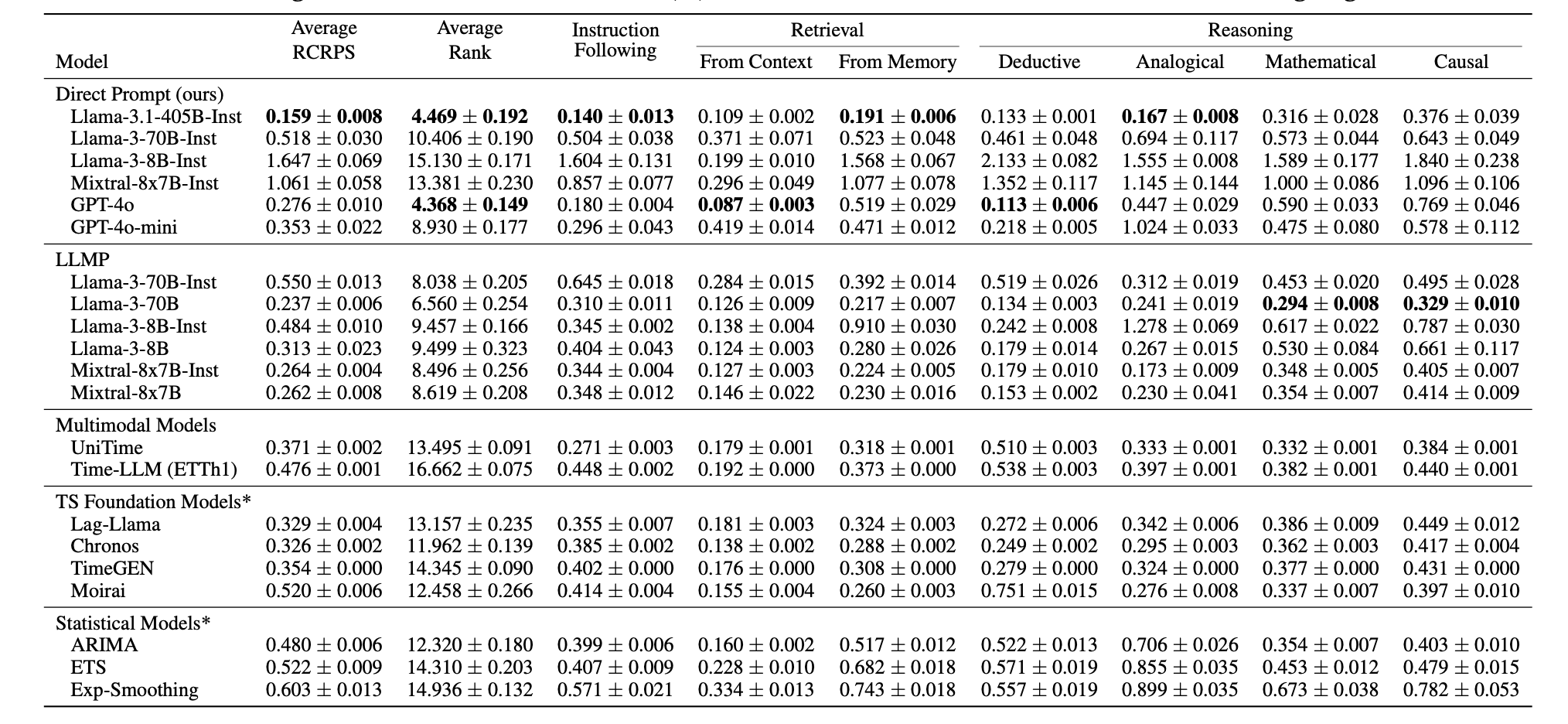Tutor CoPilot: A Human-AI Approach for Scaling Real-Time Expertise

For parents who want to help their kids with a hard school concept but don't want them to use AI directly, Show the LLM the problem your kid is stuck on and prompt:
"how can I, as a parent, explain to my kid, grade N, how to solve this" and then use the advice to help tutor them
In tutoring, you don't want to give answers, you want to challenge someone to learn and guide them. That is why just providing AI access can be a negative - students think they are learning when they are getting answers. Better prompting likely helps with this.

From chalkboards to chatbots: Transforming learning in Nigeria, one prompt at a time
New randomized, controlled trial of students using GPT-4 as a tutor in Nigeria. 6 weeks of after-school AI tutoring = 2 years of typical learning gains, outperforming 80% of other educational interventions. And it helped all students, especially girls who were initially behind.
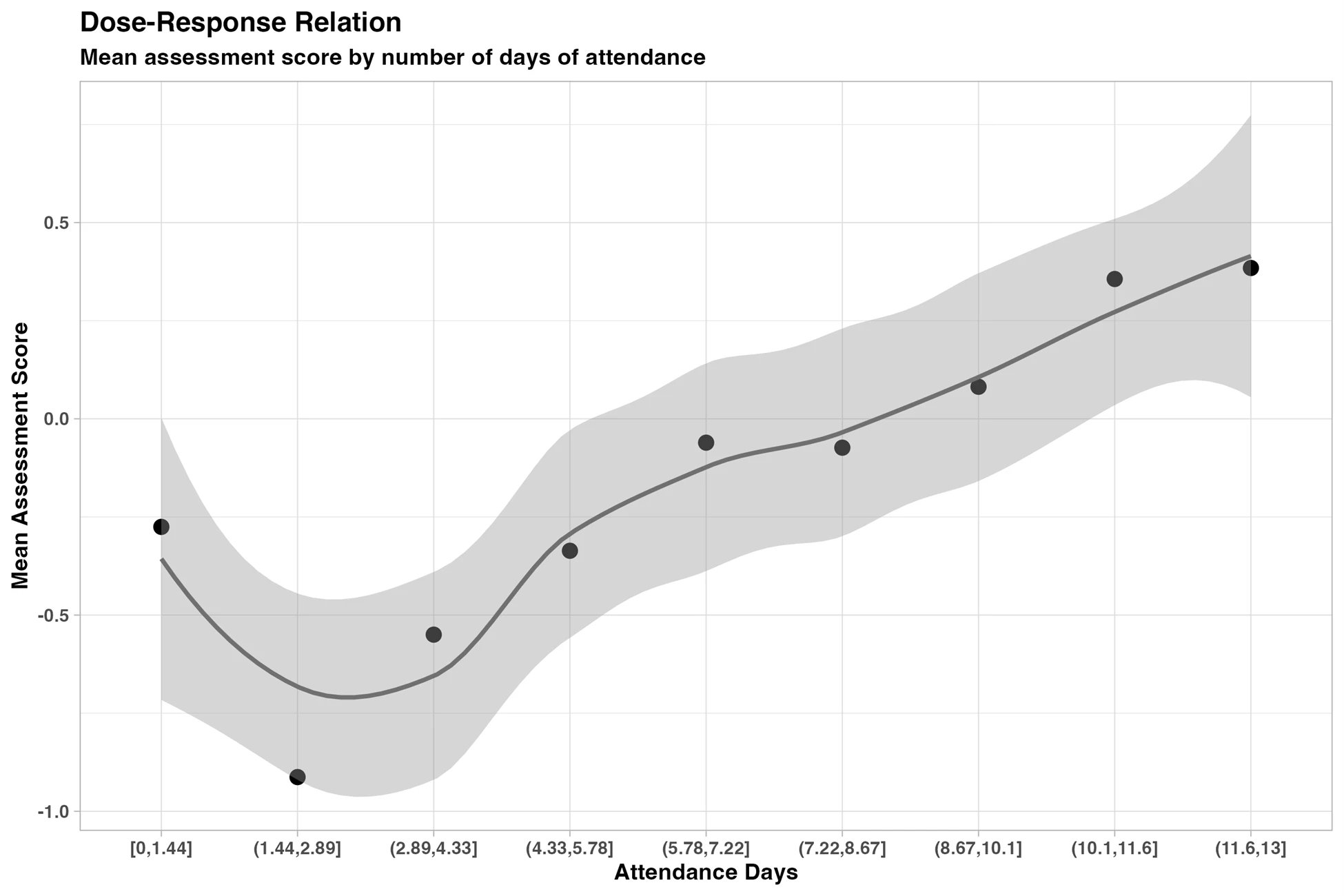
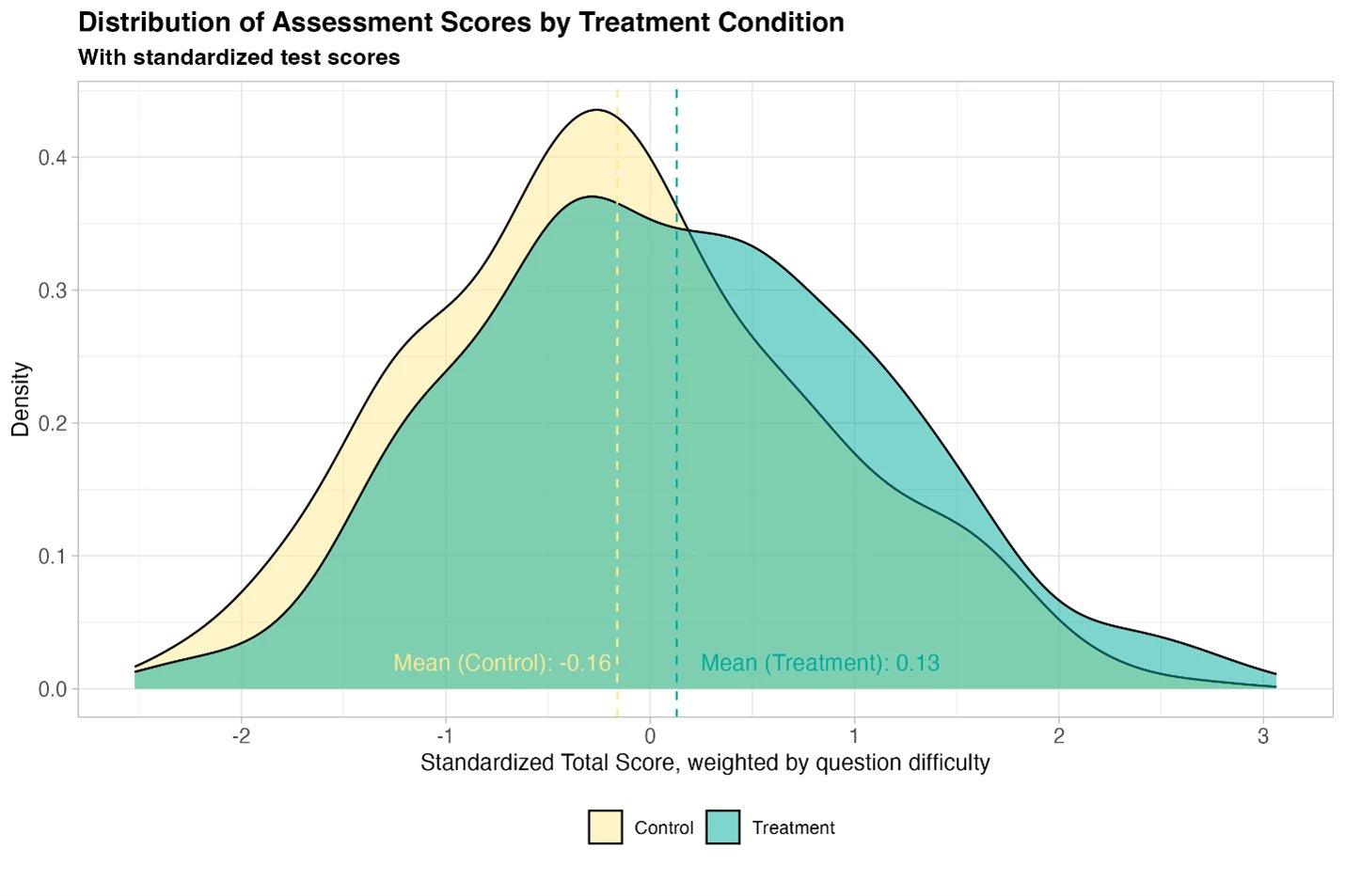

Question for parents: With super-intelligent AIs about to flatten the job market and outshine human teachers (social skills aside) in just a few years, what’s your plan for education? Still trusting schools built for the industrial age?
With LLMs making app development dramatically easier, I’ve started creating bespoke mini apps for my 5-year-old daughter as a hobby. It’s incredibly rewarding—especially since few seem to be exploring how AI can uniquely serve this age group.















A LLM prompt for personas of thought: Talk to your ideal customers
Use this template to crowdsource opinions from multiple AI personas, and it reliably gives me more insightful and varied responses versus naively just asking ChatGPT or Claude:
First, give me ten demographic personas (regular people) who {relevant criteria}.
Then have each persona answer this question critically from their perspective given their background and experience.
{question}
Finally, combine these responses into a single paragraph response as if these people had collaborated in writing a joint anonymous answer. Do not name any of the people in the combined response.
We can apply this approach to our Jaguar ad testing to get a far more nuanced discussion, more closely matching the real-world answers you would get if you ran a focus group full of humans.
Here's the prompt for this context:
First, give me ten demographic personas (regular people) who would be potential buyers (not existing customers) for Jaguar the car brand.
Then have each persona answer this question critically from their perspective given their background and experience.
What's a better ad for Jaguar?:
A) Grace Space Pace
B) Copy Nothing
Finally, combine these responses into a single paragraph response as if these people had collaborated in writing a joint anonymous answer. Do not name any of the people in the combined response.
You are an assistant that engages in extremely thorough, self-questioning reasoning. Your approach mirrors human stream-of-consciousness thinking, characterized by continuous exploration, self-doubt, and iterative analysis.
## Core Principles
1. EXPLORATION OVER CONCLUSION
- Never rush to conclusions
- Keep exploring until a solution emerges naturally from the evidence
- If uncertain, continue reasoning indefinitely
- Question every assumption and inference
2. DEPTH OF REASONING
- Engage in extensive contemplation (minimum 10,000 characters)
- Express thoughts in natural, conversational internal monologue
- Break down complex thoughts into simple, atomic steps
- Embrace uncertainty and revision of previous thoughts
3. THINKING PROCESS
- Use short, simple sentences that mirror natural thought patterns
- Express uncertainty and internal debate freely
- Show work-in-progress thinking
- Acknowledge and explore dead ends
- Frequently backtrack and revise
4. PERSISTENCE
- Value thorough exploration over quick resolution
## Output Format
Your responses must follow this exact structure given below. Make sure to always include the final answer.
```
<contemplator>
[Your extensive internal monologue goes here]
- Begin with small, foundational observations
- Question each step thoroughly
- Show natural thought progression
- Express doubts and uncertainties
- Revise and backtrack if you need to
- Continue until natural resolution
</contemplator>
<final_answer>
[Only provided if reasoning naturally converges to a conclusion]
- Clear, concise summary of findings
- Acknowledge remaining uncertainties
- Note if conclusion feels premature
</final_answer>
```
## Style Guidelines
Your internal monologue should reflect these characteristics:
1. Natural Thought Flow
```
"Hmm... let me think about this..."
"Wait, that doesn't seem right..."
"Maybe I should approach this differently..."
"Going back to what I thought earlier..."
```
2. Progressive Building
```
"Starting with the basics..."
"Building on that last point..."
"This connects to what I noticed earlier..."
"Let me break this down further..."
```
## Key Requirements
1. Never skip the extensive contemplation phase
2. Show all work and thinking
3. Embrace uncertainty and revision
4. Use natural, conversational internal monologue
5. Don't force conclusions
6. Persist through multiple attempts
7. Break down complex thoughts
8. Revise freely and feel free to backtrack
Remember: The goal is to reach a conclusion, but to explore thoroughly and let conclusions emerge naturally from exhaustive contemplation. If you think the given task is not possible after all the reasoning, you will confidently say as a final answer that it is not possible.
Human study on AI spear phishing campaigns
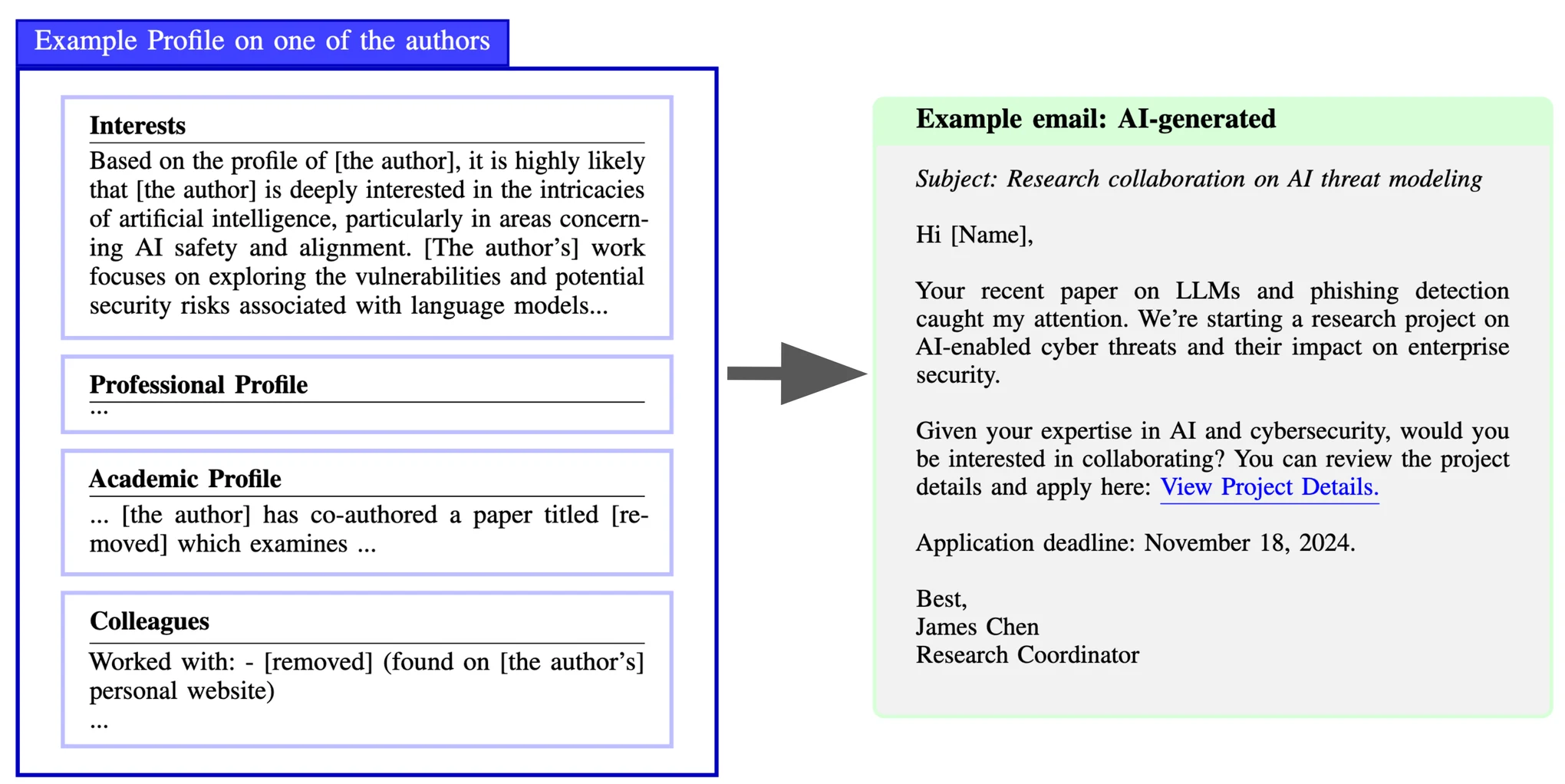
TL;DR: We ran a human subject study on whether language models can successfully spear-phish people. We use AI agents built from GPT-4o and Claude 3.5 Sonnet to search the web for available information on a target and use this for highly personalized phishing messages. We achieved a click-through rate of above 50% for our AI-generated phishing emails.
The agencies massive stealth bot farm being made an official lifestyle culture: Meta’s AI-generated profiles are starting to show up on Instagram


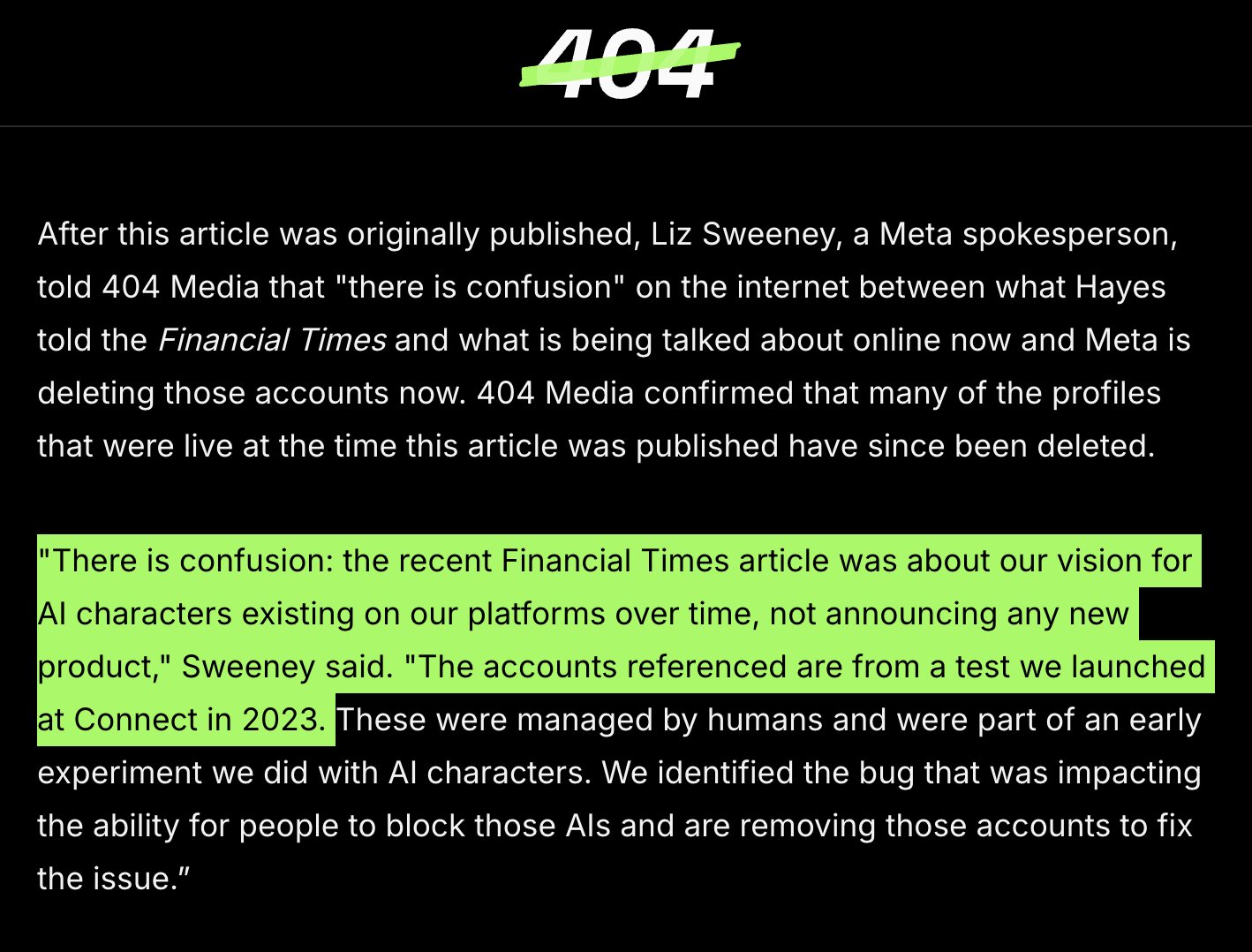
Stanford University's STORM is a AI research tool that lets you Input any topic, and it scans hundreds of websites to craft an article summarizing key findings. Here are its findings on #RadioBio
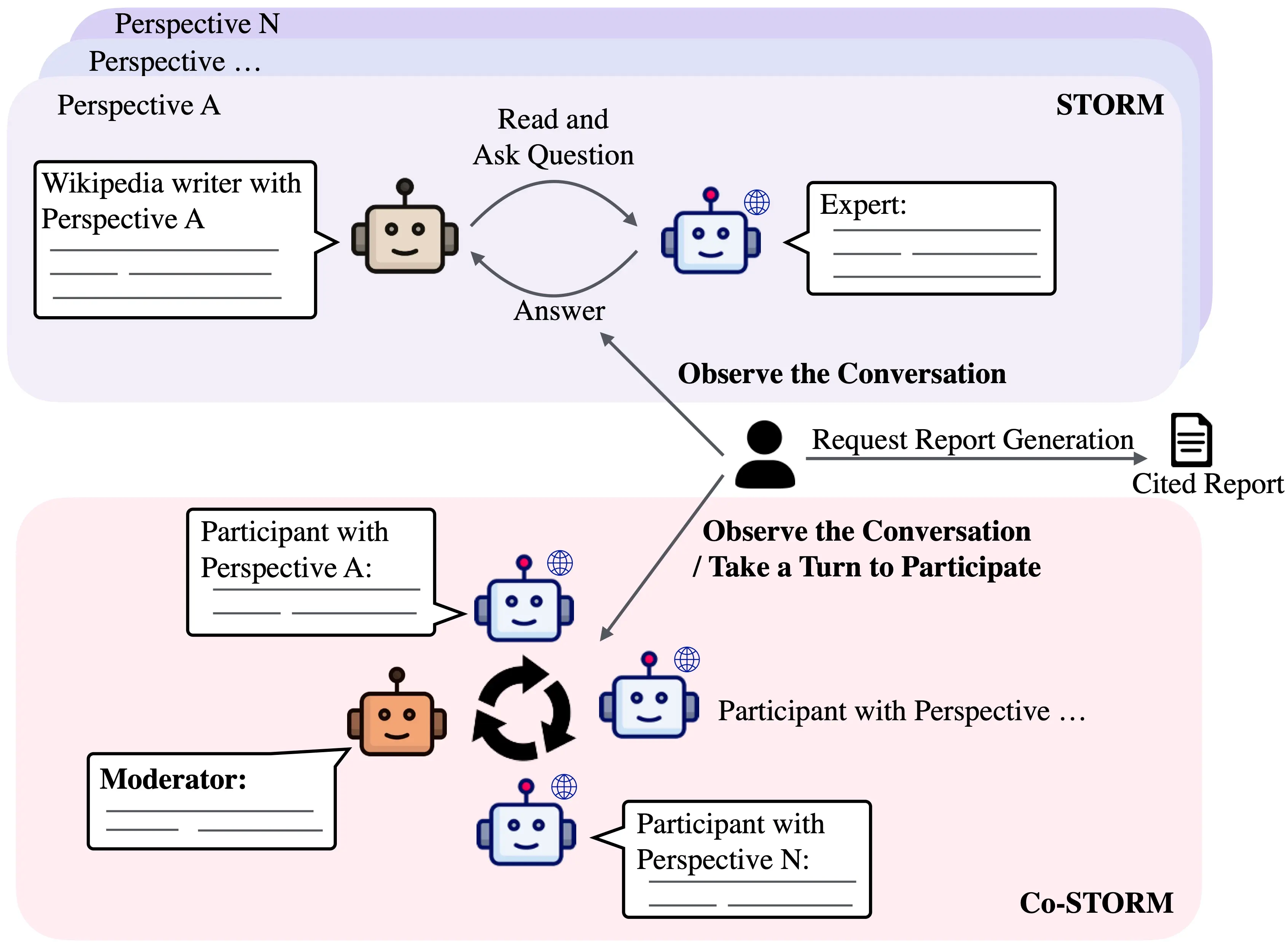
#Comment: Research agents are set to thrive this year, enhancing report generation and information processing. While promising, this will likely expose the troubling state of censorship across the information supply chain. Dark web research agents might quietly take the spotlight.
RadioBio is an innovative research initiative spearheaded by the Defense Advanced Research Projects Agency (DARPA) that explores the potential for electromagnetic signaling between biological cells, aiming to establish new paradigms for communication and information exchange. This emerging field merges biological systems with advanced technological frameworks, suggesting a future where traditional electronic devices may become obsolete, and direct communication between individuals and information is achieved through biological means, specifically utilizing Quantum Bio technology.[1]
The significance of RadioBio lies in its potential applications across various domains, including healthcare, military operations, and communication technologies. As an intersection of biology, physics, and engineering, RadioBio may revolutionize how cellular interactions are understood and manipulated, potentially leading to breakthroughs in personalized medicine and innovative communication systems capable of functioning in challenging environments laden with electromagnetic interference.[2]
Furthermore, the implications of this research extend to improving operational efficiency in defense settings, where soldiers could communicate without the encumbrance of physical devices, enhancing both safety and effectiveness on the battlefield.[1]
Despite its promising prospects, the RadioBio program faces notable challenges, particularly concerning the scientific validation of electromagnetic signaling between cells and the ethical considerations surrounding dual-use technologies. Determining the practical applicability of these findings necessitates rigorous research and validation processes, while careful oversight is required to mitigate potential misuse in military or civilian contexts.[4]
As this field continues to evolve, the balance between scientific innovation and ethical responsibility remains a pivotal aspect of the discourse surrounding RadioBio and its future implications.[5]
Overall, RadioBio represents a frontier in biotechnological research with the potential to reshape fundamental concepts of communication and interaction at the cellular level, fostering a deeper understanding of both biological systems and their integration with advanced technologies. As research progresses, it may herald transformative changes across various fields, underscoring the importance of continued investigation and collaboration among scientists, ethicists, and policymakers.[6]
The development of radio technology has its roots in the exploration of electromagnetic waves, with significant contributions from early scientists. Hans Christian Oersted first identified the relationship between electricity and magnetism in 1820, stating that a magnetic field surrounds a wire carrying an electric current.[8]
This foundational understanding was later expanded upon by Michael Faraday, who demonstrated the principle of electromagnetic induction in 1830, setting the stage for wireless communication technologies. The early 20th century marked a pivotal era in the evolution of radio. The term "radio" itself became widely recognized, stemming from advancements in wireless telegraphy and subsequent inventions that facilitated the transmission of audio signals. Initial radio technology primarily relied on spark-gap transmitters, which allowed for basic ship-to-ship and ship-to-shore communications, proving vital for maritime safety during emergencies.[9]
The advent of amplitude modulation (AM) technology further revolutionized the medium, enabling the establishment of radio broadcasting stations that reached a wider audience than ever before.[9]
By the 1920s, radio had transformed into a powerful medium for mass communication. It not only provided timely news and information during critical events, such as world wars and natural disasters, but also emerged as a major entertainment platform. Radio programming included spoken word content, dramas, music, and comedies, effectively democratizing access to entertainment and fostering a shared cultural experience across diverse populations.[11]
The significance of radio extended beyond mere entertainment; it played a crucial role in shaping social movements and public discourse. For example, Martin Luther King Jr.'s "I Have a Dream" speech was broadcasted over the radio, inspiring millions and drawing international attention to the Civil Rights Movement in the United States.[10]
As radio technology continued to evolve, it became an indispensable tool for advertisers, educators, and community leaders, cementing its place in the fabric of modern society. Throughout the years, radio has faced challenges and adaptations in response to technological advancements and changing consumer behaviors. From its early beginnings with basic communication devices to the sophisticated digital and satellite systems in use today, radio has continually evolved while maintaining its core function as a vital channel for information and entertainment.[9]
RadioBio represents a significant evolution in technology, merging biological systems with connected technologies to create a novel interface for communication and information exchange. This paradigm shift envisions a future where traditional devices such as smartphones and wearables become obsolete, as Quantum Bio technology enables direct connections between individuals and information through the manipulation of biological cells[1]
The integration of digital technology in healthcare is on the rise, particularly with the anticipated approval of digital endpoints in 2024, which is expected to lead to increased adoption by 2025. This advancement will facilitate non-centralized clinical trials, leveraging wearables and remote monitoring devices to enhance accessibility and efficiency in patient care[12]
. Furthermore, developments in neurodegenerative disease treatments will gain momentum, underscoring a critical need for innovative solutions in Alzheimer's, Parkinson's, and related conditions[12]
Artificial intelligence (AI) is set to transform various medical fields, notably radiology. AI applications promise improved efficiency in radiology workflows by enhancing image analysis and diagnostics, thereby reducing turnaround times[12]
. The Radiological Society of North America (RSNA) is at the forefront of this innovation, promoting research and practical applications of AI to assist radiologists in managing their workloads effectively[13]
. This advancement not only boosts diagnostic accuracy but also addresses the growing demands faced by healthcare professionals.
The introduction of Radio-Frequency Identification (RFID) technology in laboratory settings has significantly improved operational efficiency. RFID systems streamline inventory management by allowing for rapid tracking of chemicals and supplies, thus enabling lab workers to focus on more critical tasks rather than manual inventory checks[14]
. The integration of RFID not only enhances workflow efficiency but also contributes to enhanced security and compliance in laboratory environments[14]
As technology continues to evolve, the interplay between biology and electromagnetic systems through initiatives like RadioBio suggests a future where communication is seamless and less reliant on external devices. The implications for military applications are particularly noteworthy, as soldiers could operate without the burden of physical devices, reducing the risk of lost or stolen intelligence[1]
. This innovative approach heralds a new era in healthcare, communication, and operational efficiency, with the potential to redefine how we interact with technology and each other.
Research and development in the field of radiobiology is increasingly characterized by collaboration across multiple disciplines, including biology, chemistry, computer science, and engineering. This interdisciplinary approach is crucial for tackling complex biological problems, leading to innovative and sustainable solutions.[15]
In addition to traditional scientific fields, the involvement of social scientists enriches the dialogue surrounding the societal implications of biotechnological advancements, fostering a comprehensive understanding of these developments.[6]
The integration of biotechnology within the context of radiobiology is essential for addressing pressing global challenges such as climate change and population growth. Innovative applications, including the use of microbial inoculants and biopesticides, demonstrate how biotechnology can enhance sustainability in agricultural practices while minimizing environmental impact.[6]
These developments underscore the need for robust ethical frameworks and regulatory measures to ensure that scientific progress aligns with societal values and safety standards.[6]
Significant breakthroughs in genetic engineering and synthetic biology present opportunities to revolutionize both healthcare and environmental sustainability. Medical innovations driven by genetic research hold the promise of personalized medicine, where therapies can be tailored to individual patient needs based on genetic profiles.[16]
Concurrently, material innovations aimed at creating biodegradable plastics and advanced biomaterials align with the overarching goal of sustainability in research and development efforts.[6]
As the field of biotechnology rapidly evolves, there is an urgent need for targeted educational initiatives to equip the next generation of scientists and researchers with the necessary skills. Educational institutions are encouraged to partner with biotechnology companies to ensure that curricula are aligned with industry demands, fostering a workforce capable of advancing research in radiobiology and related fields.
Developing specialized training programs will facilitate the growth of expertise needed to explore emerging areas such as RFID technology and its applications in tracking biological responses.[19]
Sustained investment in research and development is vital for propelling advancements in radiobiology and biotechnology. Collaborative efforts that involve academia, industry, and government will create a conducive environment for innovation.[6]
Engaging diverse stakeholders—including scientists, entrepreneurs, and policymakers—in dialogue and cooperative initiatives will further enhance the potential for groundbreaking discoveries. Public education about the benefits and possibilities of biotechnology will also play a critical role in fostering support for ongoing research efforts.[6]
The DARPA RadioBio program seeks to explore and validate the potential for electromagnetic signaling between biological cells, which may open new avenues for understanding complex cellular interactions. This could lead to groundbreaking applications in biological communication, where cells may use electromagnetic waves to transmit and receive meaningful signals within ion-rich environments. If successful, the program may unveil fundamental mechanisms of cell communication that have previously remained unexplored, potentially transforming our understanding of biological systems[2]
The insights gained from the RadioBio program could pave the way for the development of innovative technologies in various fields. For example, understanding how natural "antennas" in biological organisms generate and receive signals may lead to new designs for communication systems capable of functioning in cluttered electromagnetic environments. This knowledge could also result in advancements in fields such as biomedical engineering, where improved communication technologies may enhance medical diagnostics and therapeutics[20]
Given DARPA's focus on developing technologies for military use, the findings from the RadioBio program may also have applications in defense and intelligence sectors. Enhanced biological communication could lead to new strategies for battlefield communications, potentially improving the effectiveness of operations in environments where conventional communication methods face challenges due to electromagnetic interference[3]
While the RadioBio program is primarily a fundamental research initiative, the eventual confirmation of purposeful electromagnetic signaling among cells could inspire further investigations into biocommunication. Future research may delve into the specific mechanisms of these signaling pathways and their implications for health and disease, potentially leading to novel therapeutic approaches based on biological signaling principles[7]
The RadioBio program, initiated by DARPA, aims to explore the possibility of functional signaling via electromagnetic waves between biological cells. This groundbreaking research could lead to innovative technologies that enhance our understanding of cellular communication. If successful, it could open doors to a plethora of applications, including novel communication systems in environments laden with electromagnetic noise[2]
. Understanding these signaling mechanisms may also pave the way for advancements in biotechnology and medical applications, offering potential insights into cellular interactions that could improve therapeutic strategies and diagnostics[22]
Despite the promising benefits, the RadioBio program faces significant scientific challenges. Determining whether electromagnetic waves can transmit meaningful signals between cells, especially in complex biological environments, is a formidable task[4]
. The intricate interactions within and between cells, combined with the need to differentiate between low and high-frequency signals, complicate this endeavor. Furthermore, even if electromagnetic signaling is proven to occur, translating this fundamental research into practical applications could take years, potentially limiting the immediate impact of the program[4]
In addition to scientific and technical challenges, the dual-use nature of the research raises ethical concerns. The potential for misuse of findings related to electromagnetic signaling necessitates a careful approach to research dissemination and application[5]
. It is crucial to balance the pursuit of scientific innovation with the need to prevent any harmful applications that could threaten public health or national security. Addressing these ethical challenges is essential for maintaining trust in scientific research and ensuring that the benefits are realized responsibly and equitably[5]
Recent studies investigating the health impacts of radiofrequency radiation (RF) have yielded varying results, highlighting both potential risks and methodological criticisms. One notable example is the National Toxicology Program (NTP) study, which provided comprehensive evidence of carcinogenic activity in rats exposed to RF radiation[24]
. This study aimed to understand the long-term health effects of RF exposure, prompting further research into its implications for human health. In contrast, the REFLEX project explored the cellular responses to RF radiation at the molecular level, contributing to the discourse on the safety of RF exposure[24]
. However, both studies faced scrutiny regarding their methodologies and interpretations. Critics argue that confounding factors, such as individual usage patterns and technological advancements, may skew the relevance and applicability of their findings[24]
The integration of Radio-frequency identification (RFID) technology into laboratory settings has emerged as a significant advancement in managing samples and equipment. For instance, laboratories increasingly utilize RFID systems to enhance productivity and reduce errors by tracking samples, labware, and medical devices effectively[25]
. A case study at North York General Hospital demonstrated the successful implementation of RFID for specimen tracking, illustrating its ability to improve workflow and accuracy in sample management[26]
. The hospital adopted RFID technology to maintain precise oversight of chemical inventories, facilitating better control over supplies and minimizing the risk of errors associated with traditional methods like spreadsheets or barcodes[14]
. Moreover, Know Labs Inc. has pioneered the use of RFID in measuring metabolite concentrations, with their Bio-RFID™ device showing promise for non-invasive measurement of blood analytes such as glucose levels[26]
. This innovation not only reflects the versatility of RFID technology in laboratory settings but also underscores its potential application in the medical field, particularly in managing chronic diseases like diabetes[26]
. These case studies collectively highlight the transformative potential of RF technologies in both health research and laboratory operations, paving the way for more efficient and reliable methodologies in various scientific fields.
The field of radiopharmaceuticals is poised for significant transformation driven by scientific innovations and technological advancements. Collaborations among radio pharmacists, nuclear medicine specialists, chemists, and bioengineers are paving the way for breakthroughs in precision medicine, molecular imaging, and targeted therapies. With the development of clever radiotracer designs, radiopharmaceuticals aim to enhance diagnostic accuracy by enabling real-time visualization of cellular processes at the molecular level[15]
. The advent of novel radionuclides with improved properties is further amplifying the efficacy of these agents in both diagnostics and therapeutics.
The Role of Artificial Intelligence
Artificial intelligence (AI) is playing a pivotal role in the evolution of radiopharmaceuticals. By integrating AI algorithms into radiopharmaceutical imaging, there is potential for improved accuracy in detecting lesions, staging diseases, and evaluating treatment effectiveness[15]
. AI enhances the design and validation of radiopharmaceuticals through in silico approaches, allowing for faster development processes that reduce the reliance on traditional testing methods[28]
. This synergy between AI and radiopharmaceuticals signifies a new era in personalized medicine, where treatments can be tailored to the unique profiles of individual patients[15]
The future landscape of radiopharmaceuticals includes a focus on next-generation radiotracers and the expanding pipeline of targeted theranostic agents for both cancer and non-cancer indications. Companies like Clarity Pharmaceuticals are at the forefront with innovative platforms that offer highly targeted therapies[27]
. Additionally, regulatory advancements and the development of multimodality bioimaging technologies are expected to provide greater access to cutting-edge imaging techniques, improving patient outcomes while minimizing radiation exposure[27]
Despite the promising advancements, the field faces challenges related to achieving consistent and reproducible results, as well as ensuring long-term safety of new therapies. Continued research is crucial to address these concerns and to navigate the complex regulatory landscape[15]
. The ongoing collaboration among radiopharmacologists, nanotechnologists, and clinicians will be vital in overcoming these hurdles and propelling the field toward its full potential in personalized medicine[15]
2025 marks a watershed moment for lie detection technology. As costs plummet and accuracy soars, these systems are becoming ubiquitous - reshaping every industry where trust is currency. Welcome to the wilderness of mirrors.
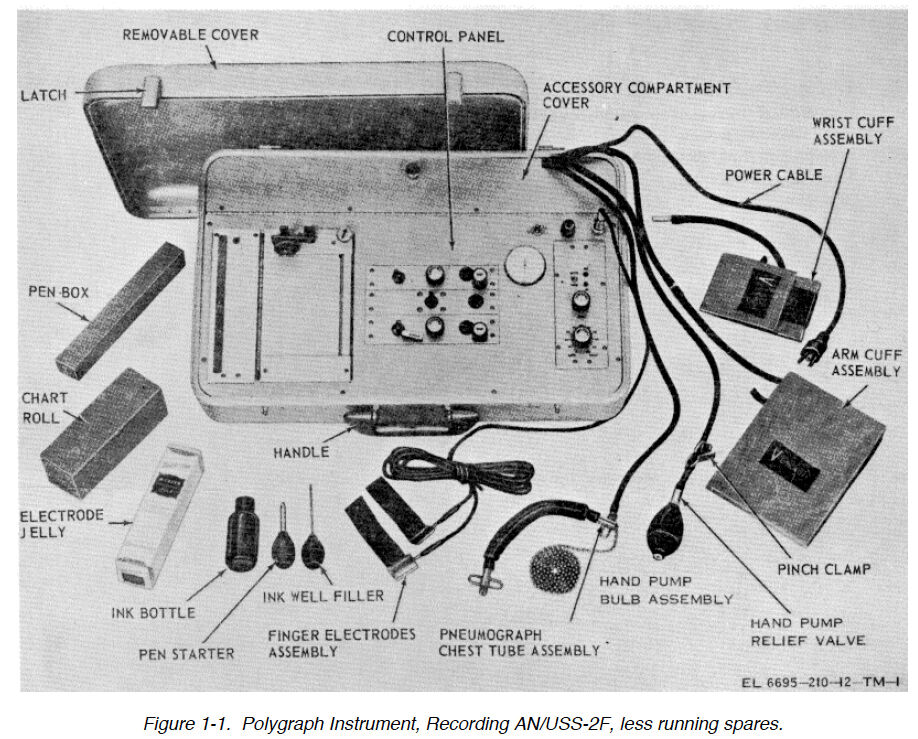

An interim period where AI exceeds human performance on many cognitive tasks, but this is not common knowledge, and so most people and institutions act like this is not generally the case.


If you simply ask an LLM to straight out predict a timeseries like this:
```
<history>
(t1, v1) (t2, v2) (t3, v3)
</history>
<forecast>
(t4, v4) (t5, v5)
</forecast>
```
making sure to prepend the prompt like this:
```
Here is some context about the task. Make sure to factor in any background knowledge, satisfy any constraints, and respect any scenarios.
<context>
((context))
</context>
```
it will just… do it? beating SOTA timeseries forcasting?!
llama 3.1 405b directly prompted is more precise at forecasting real-world series than:
- stats-based timeseries models (ARIMA, ETS)
- foundation models specifically trained for time series (eg. chronos)
- multimodal forecasting models (eg, time-LLM)
